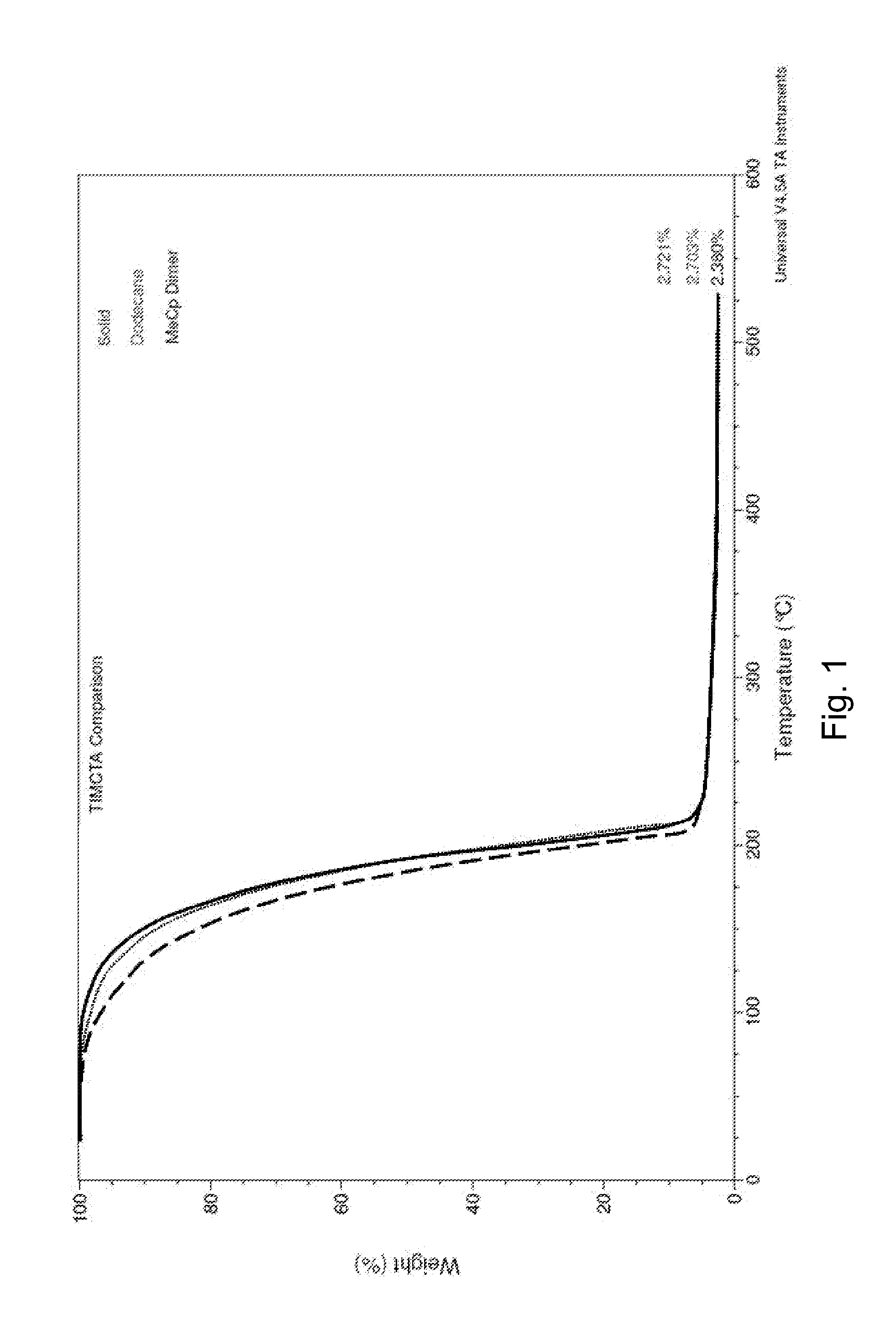Compositions and methods of use for forming titanium-containing thin films
a technology of titanium-containing compositions and compositions, applied in the direction of liquid/solution decomposition chemical coatings, organic chemistry, coatings, etc., can solve the problems of difficult control of the thickness less suited to convenient handling and use of the deposited film,
- Summary
- Abstract
- Description
- Claims
- Application Information
AI Technical Summary
Problems solved by technology
Method used
Image
Examples
example 1
1. Crude Liquid Product Preparation
[0111]In a glove box Ti(NMe2)4 (896 g, 4.0 moles) was measured out into a Schlenk. This was then transferred via catheter to a 5 Lt round bottom flask. Anhydrous toluene (2 Lt) was then transferred via catheter into the same flask. Cracked MeCpH (160 g, 2.0moles) was added over about 2 hours at room temperature. The reaction was then gradually heated to reflux, going from about 60° C. up to about 100° C. and then refluxed overnight. The flask was left to cool (<40° C.). A second batch of cracked MeCpH (160 g, 2.0 moles) was added over about 2 hours, again the reaction was gradually heated to reflux, going from 60° C. up to about 100° C. and then refluxed overnight. Solvent was removed via trap-trap under vacuum 40° C. (about 1 Torr).
[0112]NMR integration of different runs showed peaks as expected 5.8 ppm, (m, 2H, C5H4), 5.68 ppm, (m, 2H, C5H4), 3.05 ppm, (s, 18H, N(CH3)2), and 2.0ppm, (s, 3H, CH3-C5H4) although slight variations in the integration ...
example 2
Spiking MeCpTi(NMe2)3 with (MeCpH)2 Dimer
[0116]From crude liquid material supplied via LKR125, a turbo vac distillation was carried out, and the solid fraction isolated. From this, a spiking experiment was carried out to see what percentage of uncracked (MeCpH)2 would be needed to encourage the sample to liquify. In the glovebox dopak bottles were charged with MeCpTi(NMe2)3 (1 g, 3.86×10−3 mol). Spiking with 1% (0.01 g, 6.23×10−5 mol), 2% (0.02 g, 1.24×10−4 mol), 3% (0.03 g, 1.87×10−4 mol), 4% (0.04 g, 2.50×10−4 mol) and 5% (0.05 g, 3.12×10−4 mol) (MeCpH)2 dimer was carried out by simple addition and hand shaking to ensure good mixing. The samples were left overnight and 1H NMR recorded.
Prep NoNMe2Me-CpCommentsSLH 4410.285Solid fraction isolatedon turbo vac.SLH 4410.290Solid fraction with1% (MeCpH)2 dimer.Became Liquid.SLH 4410.300Solid fraction with2% (MeCpH)2 dimer.Became LiquidSLH 4410.315Solid fraction with3% (MeCpH)2 dimer.Became LiquidSLH 4410.310Solid fraction with4% (MeCpH)2...
example 3
Spiking MeCpTi(NMe2)3 with MeCpH Monomer
[0118]From crude liquid material supplied via LKR125, a turbo vac distillation is carried out, and the solid fraction isolated. From this, a spiking experiment was carried out to see what percentage of cracked MeCpH monomer would be needed to encourage the sample to liquify. In the glovebox dopak bottles were charged with MeCpTi(NMe2)3 (1 g, 3.86×10−3 mol). Spiking with 1% (0.01 g, 1.24×10−4 mol), 2% (0.02 g, 2.46×10−4 mol), 3% (0.03 g, 3.70×10−4 mol), 4% (0.04 g, 4.93×10−4 mol) and 5% (0.05 g, 6.17×10−4 mol) MeCpH monomer was carried out by simple addition and hand shaking to ensure good mixing. The samples were left overnight and 1H NMR recorded.
Prep NoNMe2Me-CpCommentsSLH 447.040.285Solid fraction isolatedon turbo vac.SLH 447.450.305Solid fraction with1% MeCpHmonomer. Becamesemi-solid.SLH 446.870.325Solid fraction with2% MeCpHmonomer.Became semi-solid.SLH 446.250.360Solid fraction with3% MeCpHmonomer.Became LiquidSLH 446.430.345Solid fracti...
PUM
| Property | Measurement | Unit |
|---|---|---|
| boiling point | aaaaa | aaaaa |
| boiling point | aaaaa | aaaaa |
| boiling point | aaaaa | aaaaa |
Abstract
Description
Claims
Application Information
 Login to View More
Login to View More - R&D
- Intellectual Property
- Life Sciences
- Materials
- Tech Scout
- Unparalleled Data Quality
- Higher Quality Content
- 60% Fewer Hallucinations
Browse by: Latest US Patents, China's latest patents, Technical Efficacy Thesaurus, Application Domain, Technology Topic, Popular Technical Reports.
© 2025 PatSnap. All rights reserved.Legal|Privacy policy|Modern Slavery Act Transparency Statement|Sitemap|About US| Contact US: help@patsnap.com

